tailgate BMW 330i TOURING 2001 E46 Owner's Manual
[x] Cancel search | Manufacturer: BMW, Model Year: 2001, Model line: 330i TOURING, Model: BMW 330i TOURING 2001 E46Pages: 203, PDF Size: 2.07 MB
Page 10 of 203

Contents
Overview
Controls and features
Cockpit16
Instrument cluster18
Indicator and warning lamps20
Multifunction steering wheel
(MFL)24
Sports steering wheel25
Hazard warning flashers26
Warning triangle26
First-aid kit26
Refueling27
Fuel specifications28
Tire inflation pressure28
Opening and closing:
Keys32
Electronic vehicle
immobilizer33
Central locking system34
Opening and closing Ð
from the outside34
Opening and closing Ð
from the inside38
Tailgate38
Cargo area40
Alarm system41
Electric power windows43
Sliding/tilt sunroof44
Adjustments:
Seats46
Seat and mirror memory49
Steering wheel50
Mirrors51
Car Memory, Key Memory52
Passenger safety systems:
Safety belts53
Airbags55
Transporting children safely58
Driving:
Steering/Ignition lock61
Starting the engine61
Switching off the engine62
Parking brake63
Manual transmission64
Automatic transmission with
Steptronic65
Turn signal indicator/
Headlamp flasher68
Washer/Wiper system68
Rear window defroster70
Cruise control71
Everything under control:
Odometer73
Tachometer73
Energy Control73
Fuel gauge74
Coolant temperature gauge74
Service Interval Display74
Check Control75
Clock75
Computer76
Technology for safety and
driving convenience:
Park Distance Control (PDC)78
Automatic Stability Control plus
Traction (ASC+T)79
Dynamic Stability Control
(DSC)80
Tire Pressure Control (RDC)85
Page 12 of 203

Contents
Owner service procedures
Advanced technology
Technical data
Replacement procedures:
Onboard tool kit152
Windshield wiper blades152
Lamps and bulbs153
Changing a wheel159
Battery162
Fuses164
Microfilter/Activated-charcoal
filter165
In case of electrical
malfunction:
Fuel filler door166
Sliding/Tilt sunroof166
Tailgate166
Assistance, giving and
receiving:
Jump-starting167
Towing the vehicle168Airbags172
Adaptive Transmission Control
(ATC)173
Automatic Stability Control plus
Traction (ASC+T)/Dynamic
Stability Control (DSC)173
Radio reception174
Four-wheel drive175
Safety belt tensioner175
Interior rearview mirror with
automatic dimmer176
Rain sensor177
Tire Pressure Control (RDC)178
Self-diagnostics179
Xenon lamps180Engine data184
Dimensions185
Weights186
Capacities187
Electrical system188
Drive belts188
Page 30 of 203
30n
Opening and closing:
Keys32
Electronic vehicle
immobilizer33
Central locking system34
Opening and closing Ð
from the outside34
Opening and closing Ð
from the inside38
Tailgate39
Cargo area40
Alarm system41
Electric power windows43
Sliding/tilt sunroof44
Adjustments:
Seats46
Seat and mirror memory49
Steering wheel50
Mirrors51
Car Memory, Key Memory52
Passenger safety systems:
Safety belts53
Airbags55
Transporting children safely58
Controls
Page 34 of 203
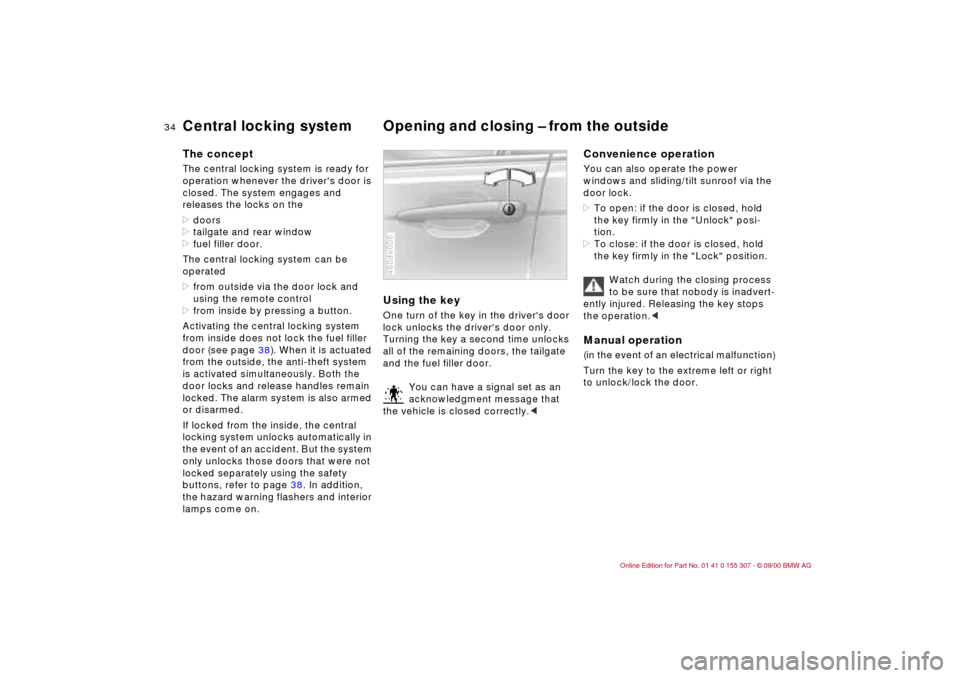
34n
Central locking system Opening and closing Ð from the outside The conceptThe central locking system is ready for
operation whenever the driver's door is
closed. The system engages and
releases the locks on the
>doors
>tailgate and rear window
>fuel filler door.
The central locking system can be
operated
>from outside via the door lock and
using the remote control
>from inside by pressing a button.
Activating the central locking system
from inside does not lock the fuel filler
door (see page 38). When it is actuated
from the outside, the anti-theft system
is activated simultaneously. Both the
door locks and release handles remain
locked. The alarm system is also armed
or disarmed.
If locked from the inside, the central
locking system unlocks automatically in
the event of an accident. But the system
only unlocks those doors that were not
locked separately using the safety
buttons, refer to page 38. In addition,
the hazard warning flashers and interior
lamps come on.
Using the keyOne turn of the key in the driver's door
lock unlocks the driver's door only.
Turning the key a second time unlocks
all of the remaining doors, the tailgate
and the fuel filler door.
You can have a signal set as an
acknowledgment message that
the vehicle is closed correctly.<460de006
Convenience operationYou can also operate the power
windows and sliding/tilt sunroof via the
door lock.
>To open: if the door is closed, hold
the key firmly in the "Unlock" posi-
tion.
>To close: if the door is closed, hold
the key firmly in the "Lock" position.
Watch during the closing process
to be sure that nobody is inadvert-
ently injured. Releasing the key stops
the operation.
to unlock/lock the door.
Page 38 of 203
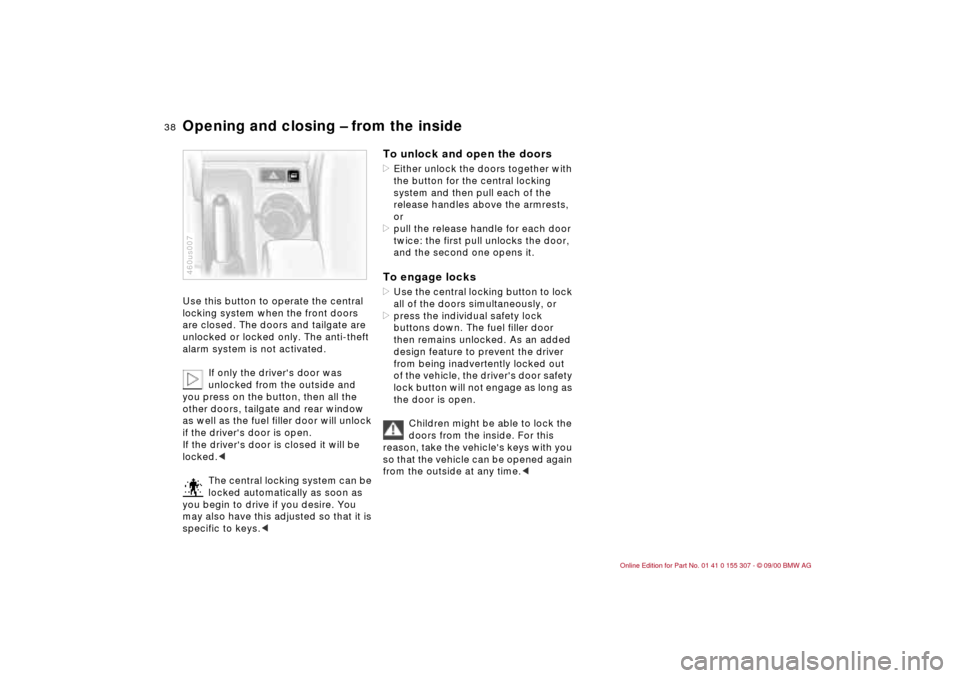
38n
Opening and closing Ð from the inside Use this button to operate the central
locking system when the front doors
are closed. The doors and tailgate are
unlocked or locked only. The anti-theft
alarm system is not activated.
If only the driver's door was
unlocked from the outside and
you press on the button, then all the
other doors, tailgate and rear window
as well as the fuel filler door will unlock
if the driver's door is open.
If the driver's door is closed it will be
locked.<
The central locking system can be
locked automatically as soon as
you begin to drive if you desire. You
may also have this adjusted so that it is
specific to keys.<460us007
To unlock and open the doors>Either unlock the doors together with
the button for the central locking
system and then pull each of the
release handles above the armrests,
or
>pull the release handle for each door
twice: the first pull unlocks the door,
and the second one opens it.To engage locks>Use the central locking button to lock
all of the doors simultaneously, or
>press the individual safety lock
buttons down. The fuel filler door
then remains unlocked. As an added
design feature to prevent the driver
from being inadvertently locked out
of the vehicle, the driver's door safety
lock button will not engage as long as
the door is open.
Children might be able to lock the
doors from the inside. For this
reason, take the vehicle's keys with you
so that the vehicle can be opened again
from the outside at any time.<
Page 39 of 203
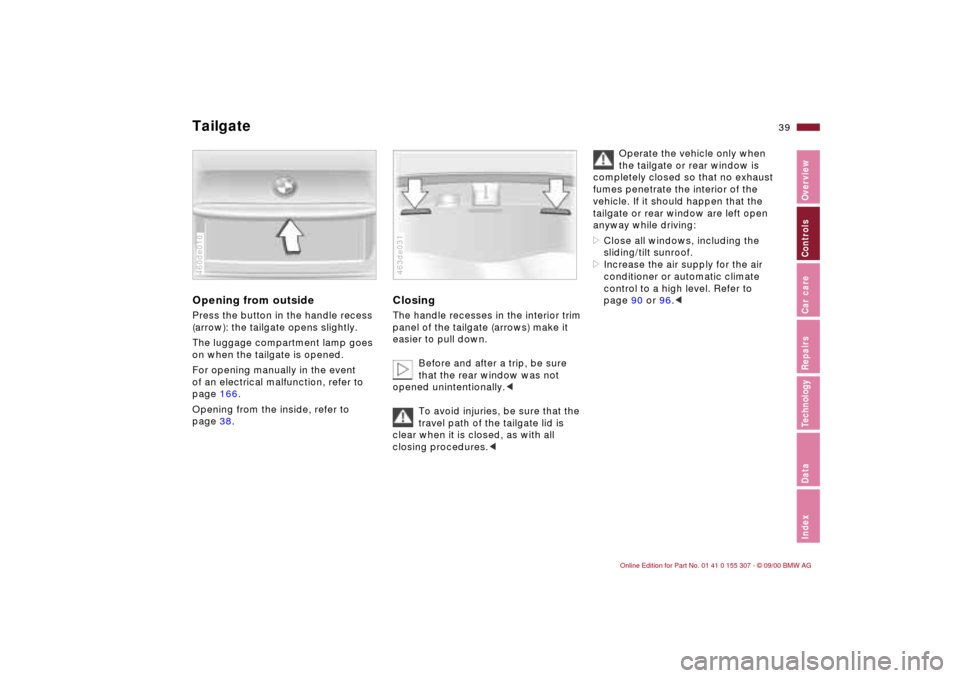
39n
IndexDataTechnologyRepairsCar careControlsOverview
TailgateOpening from outsidePress the button in the handle recess
(arrow): the tailgate opens slightly.
The luggage compartment lamp goes
on when the tailgate is opened.
For opening manually in the event
of an electrical malfunction, refer to
page 166.
Opening from the inside, refer to
page 38.460de010
ClosingThe handle recesses in the interior trim
panel of the tailgate (arrows) make it
easier to pull down.
Before and after a trip, be sure
that the rear window was not
opened unintentionally.<
To avoid injuries, be sure that the
travel path of the tailgate lid is
clear when it is closed, as with all
closing procedures.<463de031
Operate the vehicle only when
the tailgate or rear window is
completely closed so that no exhaust
fumes penetrate the interior of the
vehicle. If it should happen that the
tailgate or rear window are left open
anyway while driving:
>Close all windows, including the
sliding/tilt sunroof.
>Increase the air supply for the air
conditioner or automatic climate
control to a high level. Refer to
page 90 or 96.<
Page 40 of 203
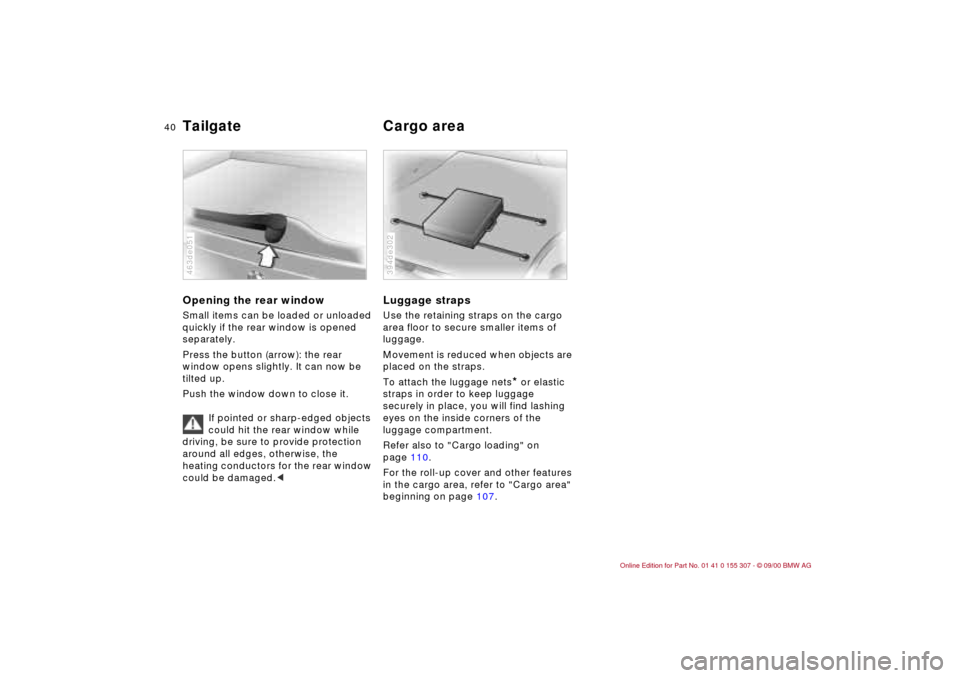
40n
Tailgate Cargo areaOpening the rear windowSmall items can be loaded or unloaded
quickly if the rear window is opened
separately.
Press the button (arrow): the rear
window opens slightly. It can now be
tilted up.
Push the window down to close it.
If pointed or sharp-edged objects
could hit the rear window while
driving, be sure to provide protection
around all edges, otherwise, the
heating conductors for the rear window
could be damaged.<463de051
Luggage strapsUse the retaining straps on the cargo
area floor to secure smaller items of
luggage.
Movement is reduced when objects are
placed on the straps.
To attach the luggage nets
* or elastic
straps in order to keep luggage
securely in place, you will find lashing
eyes on the inside corners of the
luggage compartment.
Refer also to "Cargo loading" on
page 110.
For the roll-up cover and other features
in the cargo area, refer to "Cargo area"
beginning on page 107.
394de302
Page 41 of 203
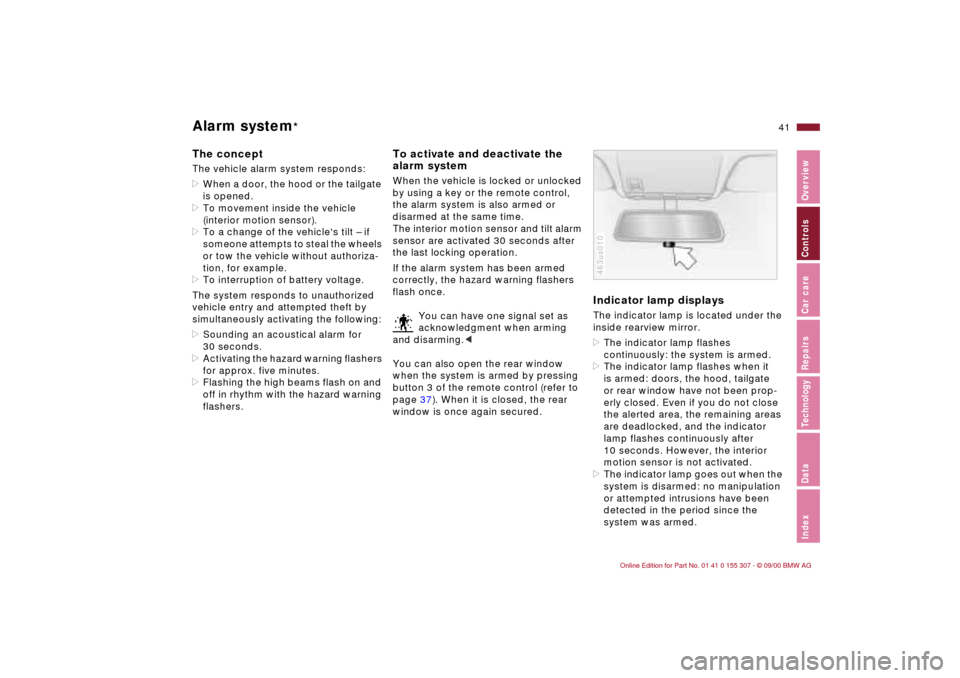
41n
IndexDataTechnologyRepairsCar careControlsOverview
Alarm system
*
The conceptThe vehicle alarm system responds:
>When a door, the hood or the tailgate
is opened.
>To movement inside the vehicle
(interior motion sensor).
>To a change of the vehicle's tilt Ð if
someone attempts to steal the wheels
or tow the vehicle without authoriza-
tion, for example.
>To interruption of battery voltage.
The system responds to unauthorized
vehicle entry and attempted theft by
simultaneously activating the following:
>Sounding an acoustical alarm for
30 seconds.
>Activating the hazard warning flashers
for approx. five minutes.
>Flashing the high beams flash on and
off in rhythm with the hazard warning
flashers.
To activate and deactivate the
alarm systemWhen the vehicle is locked or unlocked
by using a key or the remote control,
the alarm system is also armed or
disarmed at the same time.
The interior motion sensor and tilt alarm
sensor are activated 30 seconds after
the last locking operation.
If the alarm system has been armed
correctly, the hazard warning flashers
flash once.
You can have one signal set as
acknowledgment when arming
and disarming.<
You can also open the rear window
when the system is armed by pressing
button 3 of the remote control (refer to
page 37). When it is closed, the rear
window is once again secured.
Indicator lamp displaysThe indicator lamp is located under the
inside rearview mirror.
>The indicator lamp flashes
continuously: the system is armed.
>The indicator lamp flashes when it
is armed: doors, the hood, tailgate
or rear window have not been prop-
erly closed. Even if you do not close
the alerted area, the remaining areas
are deadlocked, and the indicator
lamp flashes continuously after
10 seconds. However, the interior
motion sensor is not activated.
>The indicator lamp goes out when the
system is disarmed: no manipulation
or attempted intrusions have been
detected in the period since the
system was armed.463us010
Page 75 of 203
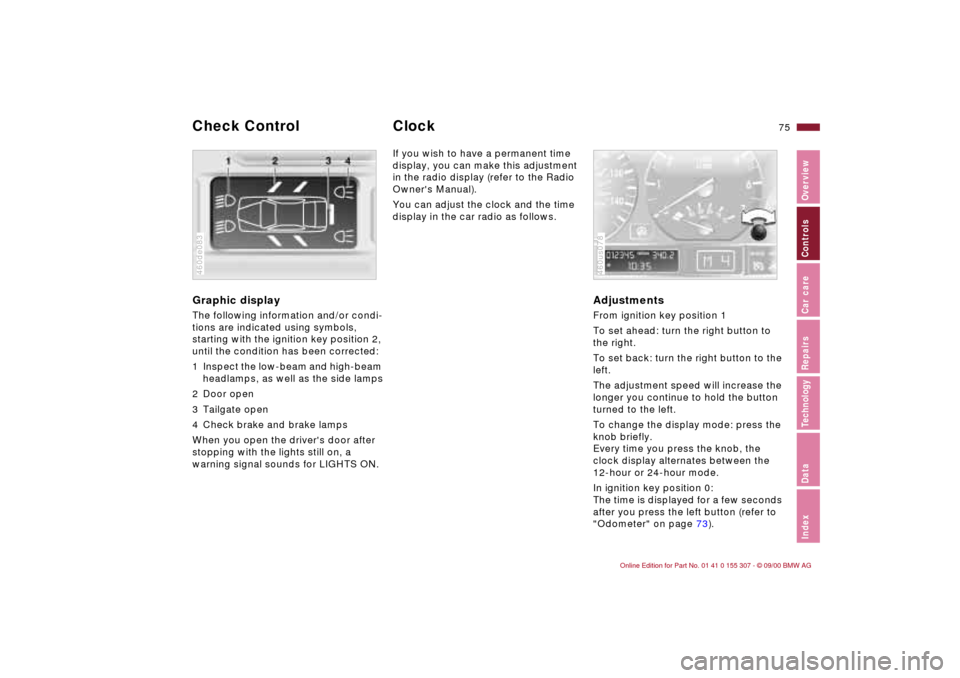
75n
IndexDataTechnologyRepairsCar careControlsOverview
Graphic display
The following information and/or condi-
tions are indicated using symbols,
starting with the ignition key position 2,
until the condition has been corrected:
1 Inspect the low-beam and high-beam
headlamps, as well as the side lamps
2 Door open
3 Tailgate open
4 Check brake and brake lamps
When you open the driver's door after
stopping with the lights still on, a
warning signal sounds for LIGHTS ON.460de083
If you wish to have a permanent time
display, you can make this adjustment
in the radio display (refer to the Radio
Owner's Manual).
You can adjust the clock and the time
display in the car radio as follows.
AdjustmentsFrom ignition key position 1
To set ahead: turn the right button to
the right.
To set back: turn the right button to the
left.
The adjustment speed will increase the
longer you continue to hold the button
turned to the left.
To change the display mode: press the
knob briefly.
Every time you press the knob, the
clock display alternates between the
12-hour or 24-hour mode.
In ignition key position 0:
The time is displayed for a few seconds
after you press the left button (refer to
"Odometer" on page 73).460us078
Check Control
Clock
Page 111 of 203
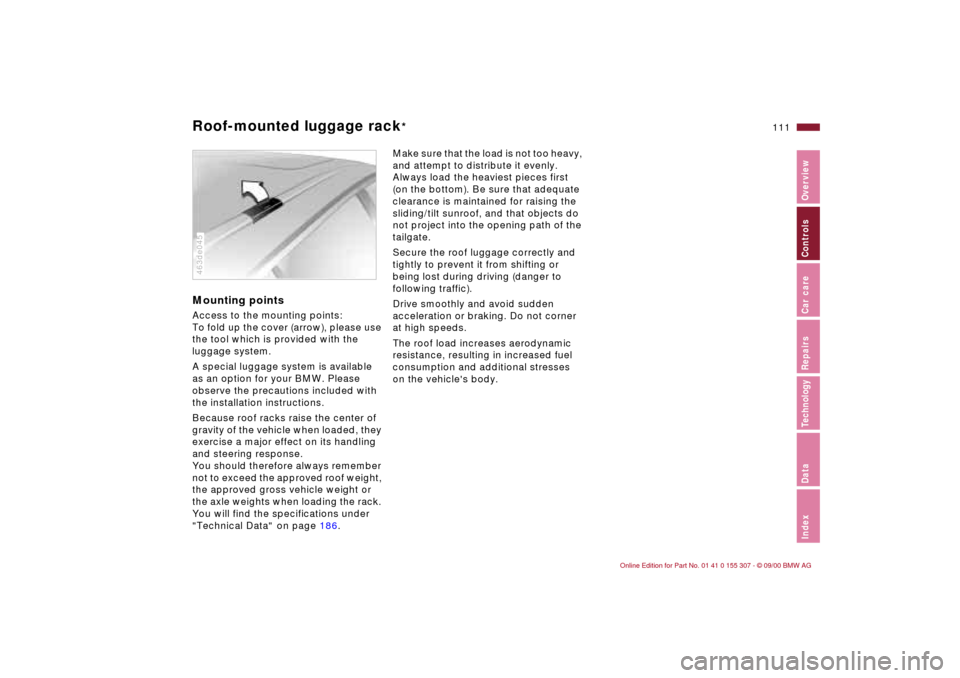
111n
IndexDataTechnologyRepairsCar careControlsOverview
Roof-mounted luggage rack
*
Mounting pointsAccess to the mounting points:
To fold up the cover (arrow), please use
the tool which is provided with the
luggage system.
A special luggage system is available
as an option for your BMW. Please
observe the precautions included with
the installation instructions.
Because roof racks raise the center of
gravity of the vehicle when loaded, they
exercise a major effect on its handling
and steering response.
You should therefore always remember
not to exceed the approved roof weight,
the approved gross vehicle weight or
the axle weights when loading the rack.
You will find the specifications under
"Technical Data" on page 186.463de045
Make sure that the load is not too heavy,
and attempt to distribute it evenly.
Always load the heaviest pieces first
(on the bottom). Be sure that adequate
clearance is maintained for raising the
sliding/tilt sunroof, and that objects do
not project into the opening path of the
tailgate.
Secure the roof luggage correctly and
tightly to prevent it from shifting or
being lost during driving (danger to
following traffic).
Drive smoothly and avoid sudden
acceleration or braking. Do not corner
at high speeds.
The roof load increases aerodynamic
resistance, resulting in increased fuel
consumption and additional stresses
on the vehicle's body.